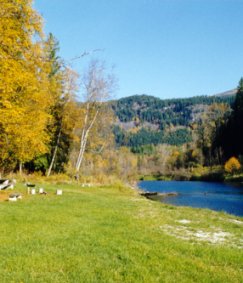Riparian Cottonwood Forests |
|

What is their history?
Since the end of the last ice age, stream courses have been created and recreated by the active processes of water movement. The formation and maintenance of cottonwood forests are closely related to the natural processes of flooding and disturbance. Many plants cannot cope with the saturated soils and periodic flooding that occur on river floodplains and along lakeshores. Black cottonwood is very resistant to flooding and regenerates best on disturbed lands, like the bare sand and gravel found on recently disturbed floodplains. The seedlings, once established, grow very rapidly and soon are able to withstand the frequent flooding. As other plants are killed off by floods, cottonwood and other flood-resistant plants survive to dominate these communities.Black cottonwood grows rapidly when young and forms dense stands on newly disturbed areas. Cottonwoods get their name from the large number of seeds they produce, which are covered with white fluffy hairs. When the seeds are dropped in full summer, the air is filled with clumps of cotton-like seeds floating on the wind.
Why are they important?
Because cottonwoods grow quickly and die relatively young, cottonwood forests include many large trees and snags (standing dead trees) which are important to a variety of wildlife species. Black cottonwood trees are an important part of riparian forest ecosystems. Riparian forests moderate aquatic habitat in streams, lakes and wetlands. The shade provided by riparian trees helps keep water cool during the heat of summer, often a critical factor for fish. Overhanging trees and shrubs drop leaves and twigs into the water and this organic matter becomes an important part of the food chain, feeding microorganisms and small invertebrates, which are in turn consumed by larger creatures. As riparian trees die, they not only provide snags for wildlife but may eventually fall into the stream where they help create cover and pool habitat for fish and other aquatic creatures. Riparian forests protect streams in other ways as well - for example, tree roots and fallen trees help stabilize stream banks and prevent erosion and siltation of stream beds.Why are cottonwood ecosystems at risk?
Black cottonwood forests are found along the banks of streams and lakes where moisture is plentiful. These are locations with rich soil, flat land, abundant water, and easy access - the exact places people wish to live and recreate. Many former black cottonwood forests have been completely cleared by human development. Settlers often cleared cottonwood forests to establish their homes and farms. Intensive livestock grazing in some of these sensitive areas has resulted in damage to soil structure, removal of understory vegetation, reduction of native plant species, and the invasion of introduced plants. Modern urban and rural development concentrates on lands within the black cottonwood ecosystem whenever possible.
Many former black cottonwood forests have been completely cleared by human development. Settlers often cleared cottonwood forests to establish their homes and farms. Intensive livestock grazing in some of these sensitive areas has resulted in damage to soil structure, removal of understory vegetation, reduction of native plant species, and the invasion of introduced plants. Modern urban and rural development concentrates on lands within the black cottonwood ecosystem whenever possible.
What can we do?
More than ever before, land managers are realizing the ecological importance of cottonwood riparian ecosystems. Remarkably little is known about these ecosystems and much more effort is needed to fully understand them. Strategies to protect black cottonwood riparian forests include:- Setting aside public lands as protected areas
- Private land stewardship
- Purchasing private land to add to protected areas
- Eliminating or reducing environmental degradation
An excellent example of a recovered black cottonwood riparian forest can be viewed on the nature trails in Winlaw Regional Park, less than a kilometer north of the Winlaw Bridge on the west side of the river in Winlaw. Take a spring trip to the forest to see a wide variety of birds and plants, and get a taste of "how it was" along parts of the river in the past!
From: Cottonwood Riparian Ecosystems of the Southern Interior, Ministry of Environment, Lands and Parks, 1997